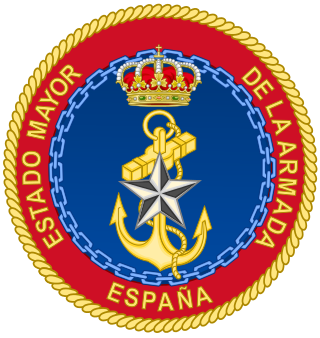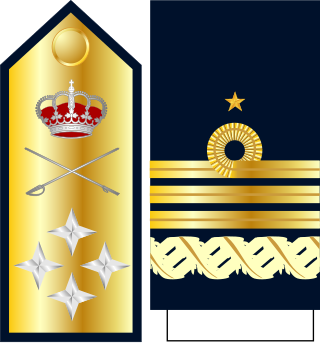
The Chief of the Defence Staff is the highest-ranking military officer in the Spanish Armed Forces and is the principal military advisor to the Prime Minister, the Minister of Defence, the National Defence Council and the National Security Council. It is the fourth military authority of the country after the Monarch, the Prime Minister and the Minister of Defence because the Secretary of State for Defence and the Under-Secretary of Defence do not have military authority.

Fernando Alejandre Martínez is Spanish Army retired officer. A General of the Army, he served as the 10th Chief of the Defence Staff from 24 March 2017 to 15 January 2020, being succeeded by air general Miguel Ángel Villarroya.

The Chief of Staff of the Navy or Admiral Chief of Staff of the Navy (AJEMA) is the highest-ranking military officer of the Spanish Navy that, under the authority of the Defence Minister, exercises command over the naval branch and, as such, is the principal military advisor to the Chief of the Defence Staff, the Minister of Defence, the Secretary of State for Defence, the Under-Secretary of Defence and the National Defence Council.

The Chief of Staff of the Air and Space Force (JEMAE) is a four-star general that under the authority of the defence minister exercises command over the Spanish Air and Space Force, and as such is the principal military advisor to the Chief of the Defence Staff, the Minister of Defence, the Secretary of State for Defence and the Under Secretary of Defence. It's also a member of the Council of Chiefs of Staff and a military advisor to the National Defence Council.

The Defence High Command was the principal staff body of the Spanish Armed Forces during the Francoist regime and the transition to democracy. It operated between 1939 and 1980, and was in charge of coordination between the staffs of the three branches of the Armed Forces.

The Board of Joint Chiefs of Staff was the highest joint military command body of the Spanish Armed Forces that operated between 1977 and 2005. The Board, subject to the political dependence of the Prime Minister, constituted the highest collegiate body of the chain of military command of Army, the Navy and the Air Force. The Board consisted of a president, selected from among lieutenant generals or admirals of the three branches of the Armed Forces, their chiefs of staff and a secretary. The president had to belong to the Group of Arms Command or Group "A" and was also chief of the Defence High Command, until the dissolution of this body in 1980. The Board also had a General Headquarters, created in 1980 as a result of the dissolution of the Defence High Command, where the organs of aid to the command were integrated. Of the General Headquarters of the JUJEM they depended:

The Defence Staff, based in Madrid, is an organ of the Ministry of Defence that operates as an auxiliary to the Chief of the Defense Staff (JEMAD) within the organic structure of the Spanish Armed Forces and in a military hierarchical position of dependence on the former.
General of the Army(Spanish: General de Ejército), also called Army General, is a four-star general officer and the second highest possible rank in the Spanish Army. A General of the Army ranks immediately above a Lieutenant general and is equivalent to an Admiral General and a General of the Air. There is no equivalent in the Civil Guard or in the Spanish Navy Marines; in both cases the top rank is Lieutenant General.
General of the Air also called Air General, is a general officer and the second highest possible rank in the Spanish Air and Space Force. A General of the Air ranks immediately above a lieutenant general and is equivalent to a general of the army and an admiral general. There is not equivalent in the Civil Guard or in the Spanish Navy Marines; in both cases the top rank is Lieutenant general.

Admiral general also called general admiral, is a four-star flag officer and the second highest possible rank in the Spanish Navy. Admiral general ranks immediately above admiral and is equivalent to a General of the Army and a General of the Air. There is not equivalent in the Civil Guard or in the Spanish Navy Marines; in both cases the top rank is Lieutenant general.
Xosé Ramón Ónega López, known in Spanish as José Ramón Ónega López, was a Spanish journalist and politician.

Manuel Díez-Alegría Gutiérrez was a Spanish military officer who served as Chief of the Defence High Command (Alto Estado Mayor, AEM) between 1970 and 1974, i.e., chief of staff of the Spanish Armed Forces during the Francoist dictatorship.

Álvaro de Lacalle Leloup was a Spanish military officer who served as President of the Board of Joint Chiefs of Staff (Junta de Jefes de Estado Mayor, JUJEM) between 1982 and 1984, i.e., chief of staff of the Spanish Armed Forces at the time.
Ignacio Alfaro Arregui was a Spanish military officer who served as Chief of the Defence High Command (Alto Estado Mayor, AEM) between 1978 and 1980, and as President of the Board of Joint Chiefs of Staff (Junta de Jefes de Estado Mayor, JUJEM) between 1978 and 1982. The offices he held made him chief of staff of the Spanish Armed Forces at the time.
Felipe Galarza Sánchez was a Spanish military officer who served as Chief of the Defence High Command (Alto Estado Mayor, AEM), and as President of the Board of Joint Chiefs of Staff (Junta de Jefes de Estado Mayor, JUJEM) between 1977 and 1978. The offices he held made him chief of staff of the Spanish Armed Forces at the time.
Francisco Laína García was a Spanish politician, who was the Director of State Security during the coup d'état of 23 February 1981. For 14 hours he headed the provisional government of Spain while Prime Minister Adolfo Suárez's government was sequestered in the Congress of Deputies.

The Ferrer-Dalmau Art and History Foundation (FFD), better known as the Ferrer-Dalmau Foundation, is a Spanish non-profit foundation founded on June 30, 2021 by the Spanish painter and academic Augusto Ferrer-Dalmau, known as the Painter of Battles. Its purpose is the dissemination, training and enhancement of the historical, artistic and cultural resources of Spain by carrying out activities such as workshops, exhibitions, forums, etc. To fulfill this task, different arts are used, such as painting, sculpture, architecture, literature, comics, music or cinema, among others.
Alfonso Pardo de Santayana y Coloma was a Spanish military officer who became General of the army and Chief of Staff of the Spanish Army (JEME).
Santiago Valderas Cañestro was a Spanish military officer, Chief of Defence Staff from 1996 to 2000.













